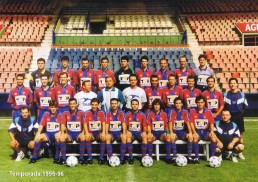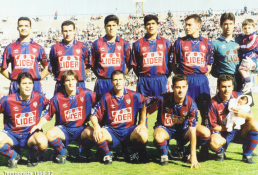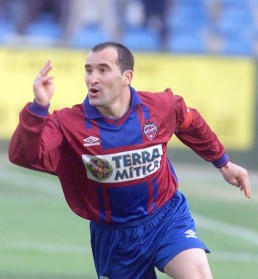Image of the squad that returned to Second A the course 1995-1996
The start of the nineties was devastating. Levante returned to the Bronze category to maintain their first adventures in the 1991-1992 and 1992-1993 seasons. The tenants on the Levante bench followed one after another. It was an unequivocal symptom of instability on the sporting front. The arrival of Jordi Gonzalvo in the second stretch of the 1993-1994 financial year produced a severe catharsis. The Catalan coach refloated a group that was capsizing in the league table. The exquisite final stretch led the Levante hosts to promotion playoffs along with Salamanca, Baracaldo and U.D. Las Palmas. The promotion went to the team from the Castilian capital.
Starting eleven during a game that season.
Levante returned to the front line of fire in the 1994-1995 campaign. That season, at the start, the team won thirteen consecutive matches. The streak was broken in a clash against Girona in the current Ciutat de València (2-2). The Levante stadium was decked out to the brim that day. The image was hopeful. With Juande Ramos on the bench and with José Luis López in the presidency, Levante acquired importance after years away from the spotlight. In that sequence of the chronology, the club closed the process of conversion into a Sports Public Limited Company following the postulates established by the managing bodies of national football.
The 1996-1997 season in the Second Division was remarkable.
The promotion resisted that season with a dramatic match against Écija (2-4) in the feared playoffs. Numancia and Pontevedra completed the group. Paco López seemed to upset Ecija in the opening act with two goals. The reaction of the Andalusian team at the restart was angry and silenced the Nou Estadi. In Ecija lands, the tie validated the promotion of the local team. However, everything changed a year later. Carlos Simón, with Abel Guillem at the club’s management, capitalized on promotion to Second A after leading a titanic promotion against Córdoba, Avilés and Racing de Ferrol. Pascual and Lucas scored the Granota goals in the decisive match against the Ferrol squad. Luck turned after five seasons away from the professional football ecosystem.
Salillas was the top scorer in Second Division A in the 1999-2000 financial year.
Mané was the coach chosen to lead the team. The Basque coach completed a superb season in his return to the Silver category. However, illusion and hope turned into despair in the 1997-1998 financial year. Emilio Cruz, José Enrique Díaz, Roberto Álvarez, Aranguren and Balaguer all sat on the Levante bench. Levante returned to Second Division B. It was an ephemeral step with Balaguer as captain of the granota ship. In promotion, the Granota squad beat Real Madrid B, Poli Almería and Bermeo. A year later, already in Second Division A, Salillas was named top goal scorer in the category with 20 goals.
At the end of the nineties, Levante took a chance on women’s football.
In the summer of 1998, Levante took over the San Vicente Valencia Women’s Soccer Club. The Levante Unión Deportiva Women’s team was officially born as a section linked to the Club. The team led by Antonio Descalzo uses the colours, as well as the symbols and the shield that characterises the granota representation. Levante was a pioneer in Spanish football by becoming one of the first clubs to have a women’s team. The successes did not take long to place Levante at the forefront of women’s football. In the 1999-2000 season year they reached the Copa de La Reina after beating Lagunak in the Grand Final (3-0). In the 2000-2001 season they overcame their opponents by winning the Super Cup, Cup and League. In the league competition, they broke all records by scoring 240 goals and conceding five.




